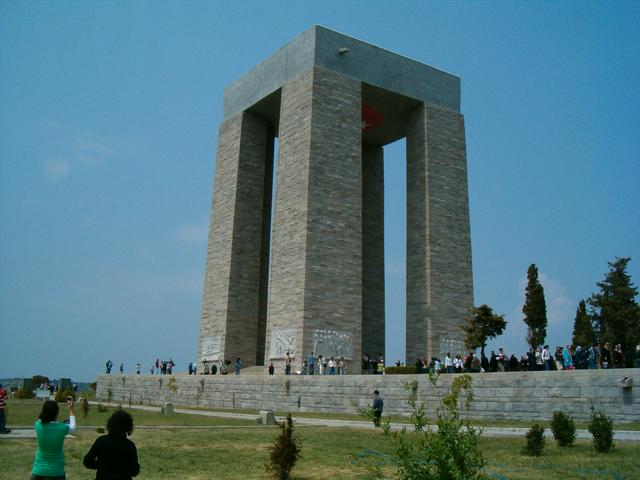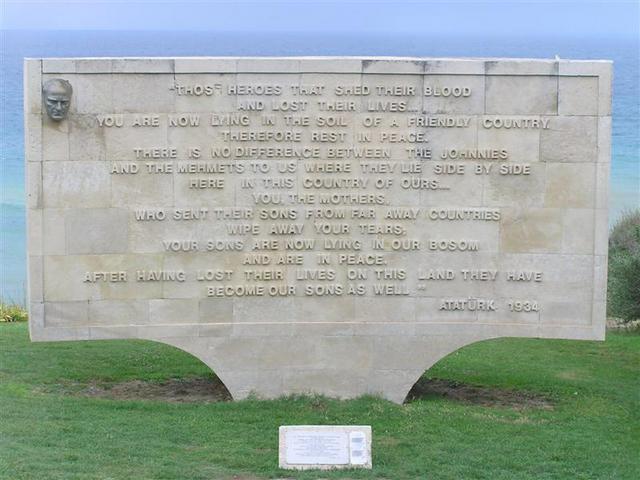
Gallipoli (Turkish: Gelibolu) is a peninsula locality in north-western Turkey, close to Istanbul. The Gallipoli Peninsula is the site of extensive First World War battlefields and memorials on the north bank of the Dardanelles Strait. It is a commemorative site for the Allied (British Empire, France) and Turkish forces who fought, died and were wounded there. The Gallipoli Campaign also known as the Battle of the Dardanelles was very costly for both sides, and casualties and losses amount to 220,000 with a 59% casualty rate for the Allied forces, and 253,000 with a 60% casualty rate for the Turkish forces.
The battle resonated profoundly among some nations involved. In Turkey, the battle is perceived as a defining moment in the history of the Turkish people—a final surge in the defence of the motherland as the centuries-old Ottoman Empire was crumbling; and in Australia and New Zealand, the then perceived duty to serve their "Mother Country" Britain, resulted in their military defeat, but their sacrifice and heroism marked the birth of a separate national consciousness in both of these countries.
The Gallipoli peninsula is one of the most sacred sites for the Turkish nation, with many monuments such as the Monument of Martyrs erected in the honor of the Turkish soldiers who died in the Battle of the Dardanelles against the Allied forces, whose defeat staved off a potential invasion of Turkey. The victory over the Allies is celebrated on 18 March as Çanakkale Zaferi (Çanakkale Victory), every year, with tens of thousands of Turks attending the events on the battlefields and memorials.
The area around Anzac Cove is particularly significant for Australians and New Zealanders, whose armies received their baptism in fire on the cliffs there, and carved a fine military reputation under extreme adversity and enormous loss of life; and this military disaster marked the beginning of a separate Australian and New Zealand nationhood. The 1915 landings and battles are commemorated by Australians and New Zealanders on ANZAC Day, 25 April, every year. At this time especially, Gallipoli becomes a place of pilgrimage for many Aussies and Kiwis who want to honour the memory of their forbears.
Gallipoli is an elongated (around 40–50 km from its one end to another) peninsula stretching southwest from Thracian mainland, between the Bay of Saros (an indentation of Aegean Sea) and the Straits of Dardanelles. The peninsula is named after a town (Gelibolu) on its northeastern tip, near where it connects to the rest of the mainland. The battles took place in scattered locations around its southwestern end, where the peninsula fronts the Aegean Sea on a coastline full of cliffs.
It was this geographical location—at the entrance of the Dardanelles, and thus on the supply route to Russia via the Sea of Marmara, Bosphorus, and the Black Sea—why the Gallipoli Campaign was planned in the first place.
In addition to the battlesites, there are plenty of pleasant vistas to be enjoyed in the peninsula, including pine forests, views over the sea from hilltops, and beautiful olive groves along the roadsides.
Average temperature values in nearby Çanakkale are as in the list to the right.

There are three main battlefield areas: Cape Helles (Turkish: Seddülbahir), Anzac Cove, Pine Ridge and Suvla Bay (which has fewer places to visit). Depending on how detailed your itinerary is, it would be possible to visit the main sites of interest, particularly around Cape Helles, Anzac Cove and Pine Ridge, in a single day. More realistically, two or three days allows plenty of time for an extensive tour, taking in all the battlefield sites, cemeteries and memorials. Must-sees include:
- Çanakkale Martyrs' Memorial.
- British Memorial at Cape Helles.
- Anzac Cove.
- Pine Ridge Australian Memorial.
- New Zealand Monument, Chunuk Bair.
- Atatürk Statue, Chunuk Bair.
Be aware that despite what certain tour operators will tell you it is entirely possible to attend the Dawn Service on ANZAC Day independent of a tour group. There are taxis from Ecebat and private vehicles and pedestrians are admitted free of charge into the park during this time. This saves arriving in the evening of 24 April and freezing overnight waiting for the service at 05:30 on 25 April.
Çanakkale Martyrs' Memorial.
British Memorial at Cape Helles.
Anzac Cove.
Pine Ridge Australian Memorial.
New Zealand Monument, Chunuk Bair.
Atatürk Statue, Chunuk Bair.
Aside from the 1915 battlefields, why not visit the new Gelibolu Milli Park visitors centre where there are excellent displays relating to the natural history of the peninsula. You can also visit the ancient fortress of Kilitbahir south of Eceabat or take a ferry across the Straits to Asia; from Çanakkale, drive to what is reputed to be the site of Ancient Troy (signposted Troia) about 30 km to the south. The ruins of the legendary city, complete with a new wooden horse, are open to the public.
On the peninsula, Eceabat is the only sizeable town close to the battlefields where you will find a good selection of places to eat. There is a restaurant in the Gelibolu 'Milli Park' visitors' centre north of Eceabat. Food and drink can be bought in smaller towns such as Alcitepe close to Cape Helles. It is, of course, important to have plenty of water with you in summer when temperatures can be quite hot. Some of the major battlefield sites have stalls selling cold drinks as well as ice cream.
The Turkish government has been keen to ensure the safety of visitors to the sites and security measures are in place at busy times around ANZAC Day of 25 April. Gallipoli is safe a destination and the locals are friendly and welcoming towards visitors. The Turks show great respect for the Allied war sites and it is of course important to show similar respect towards Turkish sites.
- Gökçeada, ancient Imbros, the largest Turkish island in the Aegean Sea, is served by a direct ferry service from the Kabatepe Harbour., located along the western shore of the peninsula.
[[Gökçeada]], ancient Imbros, the largest Turkish island in the Aegean Sea, is served by a direct ferry service from the Kabatepe Harbour., located along the western shore of the peninsula.
